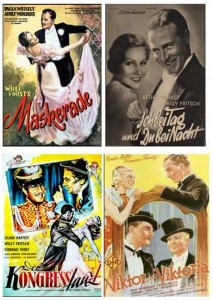 The Weimar Republic period of German history, from 1918-1933, saw economic, stylistic and cultural changes in the German film industry that would have profound effects on the history of German cinema.
The Weimar Republic period of German history, from 1918-1933, saw economic, stylistic and cultural changes in the German film industry that would have profound effects on the history of German cinema.
World War I ended with the Treaty of Versailles, and any hopes of post-war prosperity were destroyed for Germany. Germany was blamed as the sole instigator of the war and was left with huge reparations to be paid to the nations damaged by the war. Inflation quickly rose, as did poverty, and the German mark became nearly worthless. The film industry, though, grew. Germans had no reason to save money in the unstable economy and movies provided a worthwhile place to spend what little money there was. Films were also extremely cheap to make. Not only did this encourage filmmaking in Germany, it also encouraged other countries to import inexpensive German films.
At the beginning of this period, in 1919, 470 films were released. In 1920, 510 films were released. At its largest levels of production and output, the German film industry was only second to Hollywood in the number of films produced and released.
The Weimar Republic saw the growth of the Universum-Film Aktiengesellschaft (Ufa) as it acquired and absorbed many of Germany’s smaller film companies to become the country’s leading producer of films. Founded by the German government, Ufa originally served as a producer of political and World War I propaganda films.
German Expressionism began slowly, starting with Das Kabinet des Dr. Caligari (The Cabinet of Dr. Caligari) in 1920. This revolutionary film set the stage for the grand wave of German Expressionist films that would come to define the industry in the 1920s. Ernst Lubitsch came to fame due to his work with historical films like Madame Dubarry (1919). From the theatre form popularized by directors like Max Reinhardt and August Strindberg, developed alongside German Expressionism and drawing on some of the same concepts, notably psychological expression was the Kammerspiel, or chamber drama. F.W. Murnau’s Der letzte Mann (The Last Laugh) (1924) is often considered the quintessential Kammerspiel film. Comedy films, particularly slapstick, were also popular at the time. Reinhold Schunzel has been called Germany’s Charlie Chaplin and starred in many of the most popular comedies of the Weimar period. He also acted as a writer and director.
The Weimar film industry also produced a great number of detective films, many of which influenced the popular film noir of the 1940s and 1950s. Fritz Lang directed the first in a series of films, Dr. Mabuse, der Spieler (Dr Mabuse, the Gambler).
Addition the Weimar German cinema produced a large number of popular and light-hearted comedies and musicals that drew in large audiences. In a search for foreshadowing of the fascist Nazi regime in German film from the Weimar period, these films have often been brushed aside when looking at the history of German film in favor of many of the darker films of the period. However, these films proved to be especially popular with mass audiences, particularly as filmmakers continued to take cues from Hollywood, which was in a Golden Age of the movie musical.
Currently (January 2016) you can see 4 Weimar films here, 01/06/16 Maskerade with Willi Forst; 01/13/16 Der Kongress tanzt with Lilian Harvey and Willy Fritsch; 01/20/16 Ich bei Tag und Du bei Nacht with Willy Fritsch and on 01/27/16 Victor and Victoria with Renate Müller.





